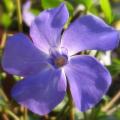General information about Vinca (Periwinkle, Myrtle):
An American classic commonly referred to as Periwinkle or Myrtle, Vinca, with her graceful,
cascading
foliage on slim
trailing
stems and delicate phlox-like
flowers,
is an irresistible garden groundcover.
Her blooms peek out in early spring and heavily cover the foliage, then sparsely persist throughout summer.
Evergreen
and utterly low-maintenance, her
lanceolate
foliage (from 1/4 to 3 1/2 inches long and 1/8- 3/16 inches broad) sits opposite one another and tends to be
low-growing
(though some varieties can grow up to 2 feet high).
It
spreads
far and wide as the long stems grow, touch the ground, and root where they touch.
Because of her
fast spreading
habit and ability to blanket an area quickly,
Vinca is useful at controlling
soil erosion
on
shady
slopes
and for covering for large blank spaces and difficult bare spots
under trees
and shrubs.
Subshrubs
with woody habits, both Vinca major and Vinca minor are highly sought after because they can completely carpet an area quickly and economically
with the added bonus of delicate
salverform
flowers willing to blossom in
shade
or
full sun.
Because she doesn’t climb, Vinca is a perfect alternative to ivy when you need a solid, resilient absolutely lovely, classic look.
Gardeners love the fact that it is tolerant of infrequent
foot traffic
and
deer.
Provided she's given frequent drinks, Vinca minor is perfect for difficult
poor soil,
surprising many gardeners with her adaptability,
but of course, she’ll blow your mind when planted in organic, moist, well-drained, loamy soil.
Things to Note
Compared to
Vinca minor,
Vinca major
is less cold hardy, more tolerant of heat, has broader, hairier leaves, larger flowers, and twice as many chromosomes.
Comparison of V. minor vs. V. major
Be aware that Vinca can be invasive, and should only be used in contained areas or spaces where she can have free run.
Only a thin layer (if any) of mulch should be used, because Vinca spreads by re-rooting where
runners touch the ground.
Interesting Facts
Vinca (from Latin vincire "to bind, fetter") is a genus of six species in the family Apocynaceae; it is native to Europe, northwest Africa and southwest Asia.
Vinca’s common name, shared with its related genus Catharanthus, is Periwinkle.
Gardener Tips
Gardeners often opt to use Vinca in flower boxes, urns and hanging baskets because of their elegant,
dangling
stems.
In a planter, consider pairing Vinca with spring bulbs, then summer annuals, followed by evergreen sprigs and berries for year-round curbside appeal.
Vinca is a lovely complement to
creeping phlox
and lavender in a rock garden.
Vinca loves to
spread, but not typically upward.
If planting Vinca on a
slope,
be sure to start at the highest point and then place plants evenly spaced down the slope.
This will ensure even, full coverage.
While all parts of the vinca plant are slightly toxic, that small amount consumed by a pet is unlikely to cause signs (loss of coordination, seizures, diarrhea, vomiting and depression). It would be best to watch your dog or cat closely over the next 24 hours, and if you see any signs of vomiting, diarrhea, lethargy, or tremors, he/she needs to be seen right away by a veterinarian.
See all Vinca.
|
 (0)
(0) Full sun
Full sun  Part sun
Part sun  Shade
Shade

